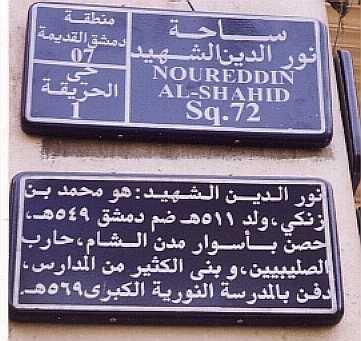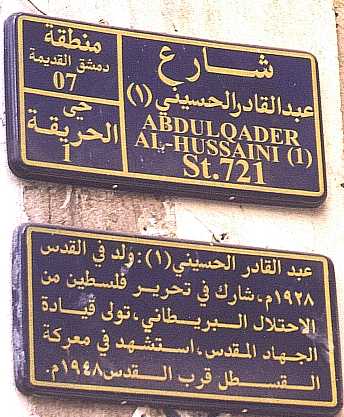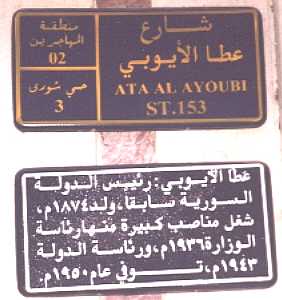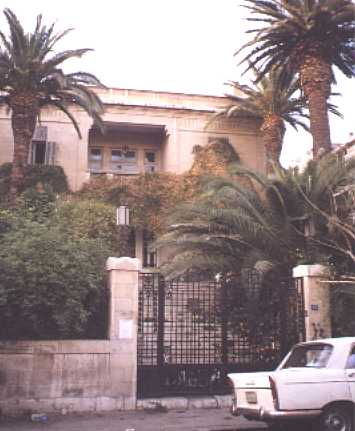Samir Raafat
Cairo Times, November 25, 1999

|
|
|
|
|
|
EGY.COM - COMMUNITY
|
|
Samir Raafat
Cairo Times, November 25, 1999

Occasionally, one is compelled to applaud Syria's omnipresent Bath party leadership. Whereas the debate at State Intelligence still rages over whether or not to let Internet into the country, with the help of local historians the people at City Hall are doing something quite worthwhile in the meantime. Rather than concentrate their efforts on the still unascertained information superhighway, they've been giving the Damascus streets a fantastic cultural facelift. And I don't mean those ad-infinitum gargantuan posters of the Great Leader. That's another story.
To date I don't know of any other Arab capital where you can walk about without getting lost for lack of adequate street signs. Even as you uncover the maze of lanes, streets and boulevards that make up Damascus, you will start appreciating its history and geography and learn something or two of the region's statesmen. Despite yourself you will derive a sense of pride for the city's varied landmarks for, like the streets, most of these too are plaqued offering Damascenes and Arab-speaking visitors a minimum of essential information.
Every Damascus road, big or small, sports large blue and white enamel street signs strategically placed at given intervals. These come in pairs. The smaller one spells out the name of the street in Arabic and in English (most times) and shows the name and number of the district and precinct you're in.
The larger street sign gives an explanation of the street name. For instance "Brazil Street" is described as follows: "Brazil is a large republic in South America which obtained its independence from Portugal in 1822; home to a large Syrian community; Brasilia is its capital and Portuguese its official language."
A similar street sign can be found at the nearby Argentina Avenue. Curiously, there is no mention that Argentina's outgoing President Carlos Menem and his former first lady, Zulema Goma'a, were themselves of Syrian stock. One supposes therefore that the joint panel which promoted the introduction of these signs three years ago escaped the monolithic party-run propaganda machine prone to blowing the nationalist trumpet whichever way it can.
Many Damascus streets commemorate cities with a colonial past. Hence Port Said is "a city created in Egypt by Viceroy Mohammed Said Pasha in the 19th century and which held out against the 1956 Tripartite invasion."
 As I walked along I was reminded of several Arab poets including two who died by the executioner's sword. Ahmed Al Mutanabi and Ali Ibn Mohammed Al Tohami. The first was attached to Sultan Seif al Dowla's court and killed in 354 Hegira while the second was killed in Egypt in 416 Hegira.
As I walked along I was reminded of several Arab poets including two who died by the executioner's sword. Ahmed Al Mutanabi and Ali Ibn Mohammed Al Tohami. The first was attached to Sultan Seif al Dowla's court and killed in 354 Hegira while the second was killed in Egypt in 416 Hegira.
If a large street is dedicated to Egypt's Ahmed Shawky aka Amir al Shoara'--Prince of poets, a hara or alley is named after the Damascene Odai Bin Al-Roq'a aka Sha'er Al Cham--Poet of Al Sham. He lived during the rule of Walid Ibn Abdel Malek dying in 95 Hegira.
Egyptian-born Mustafa Al Manfaluti is also evoked in Damascus. "Mustafa Lotfi Ibn Mohammed, an important Egyptian writer and scholar; born in 1872 died in 1924. Authored numerous works." Meanwhile, in a nearby street we learn that Shakib Arslan (1869-1946) was a contemporary Syrian author, a veteran member of the Arab Institute and founder of La Nation Arabe, a French-language paper published in Geneva. Both these gentlemen's plaques hang in the elegant Al-Muhagereen neighborhood not far from where President Hafez al-Assad lives.
Speaking of Assad, what of Arab politicians and heads of toppled governments? Do they deserve streets signs as well or have they been tabooed by their Baathist successors. There too you're in for a surprise for unlike other 'prgressive Arab states, Syria's ancien regime is not wallowing in the whimsical dustbin of Arab history.
Ok, so Hafez al-Assad and his brood get the best avenues while Gamal Abdel Nasser extends over several districts. Yet former statesmen nevertheless hang out on smaller side streets some of them tree-lined and well looked after. So that if the neoteric French chancery in Damascus does not overlook Avenue Charles de Gaulle (like in Cairo), it stands on Rue Atta Al Ayoubi. As the nearby street sign explains, Ayoubi (1874-1950) was Syria's Prime Minister (1936) and later its President (1943) during the hated French mandate period.
Municipal leaders and Damascus historians are just as concerned with the city's monuments, mosques and landmarks. No distinction is made between the sublime al-Muawiya Mosque (reference to ruler Muawiya Ibn Abu Sofian; died 60 Hegira) or the modest Al Afram mosque built this century by citizen Nour Al Shalah in the district of Abou Romana. Both have equal sized plaques. The objective remains one. To inform and educate whenever possible.
For years I've asked my townie friends who was Ibn Zanki after whom an important Zamalek street is named. Nine times out of ten I drew blanks or got the wrong answer.
For those of you who still don't know who are Ibn Zanki, Simone de Boulivar or the like, don't hold your breath waiting for our governor or his minions to make a move. Either you get your act together and force the municipality's hand into doing something about our decadent, missing or misspelled street signs, or, failing that, hop on the next plane to Damascus and eat your heart out.


Home of Atta Al Ayoubi
|
|
|
|